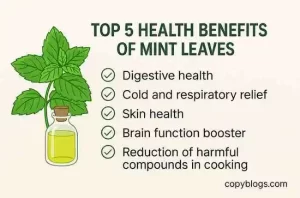
10 Amazing Mint Leaves Benefits & How to Use Them
- April 24, 2025
- by
- Shanaya
Mint leaves, well-known for their cooling flavor and fragrance, have many health benefits that make them greater than just a gastronomic pleasure. These wonderful leaves are a treasure trove of vital nutrients and antioxidants. Bringing mint leaves into your lifestyle can change your life, giving it a dash of nature’s goodness. Let’s delve into mint leaves benefits and discover the secrets of this humble herb.
Jump to:
What are mint leaves?
Before discussing the advantages of mint plants, let’s define mint leaves.
Mint leaves belong to the Mentha genus and are well-known varieties such as spearmint (Mentha spicata) and peppermint (Mentha piperita). They’re recognized for their refreshing menthol taste that flavor foods, beverages, and cosmetics.
Difference between spearmint vs peppermint
| Feature | Spearmint | Peppermint |
|---|---|---|
| Taste | Mild, sweet | Strong, cool, sharp |
| Smell | Light and fresh | Intense and minty |
| Main Use | Cooking, teas, skin care | IBS relief, muscle rubs, aromatherapy |
| Strength | Gentle | Stronger and more concentrated |
| Cooling effect | Light cooling | Very cooling (due to high menthol) |
| Good for digestion? | Yes – gentle on the stomach | Yes – strong relief for cramps, IBS |
| Safe for skin? | Yes, generally safe | Can be irritating if not diluted |
| Best for | Everyday use, flavoring food/drinks | Targeted relief (headaches, IBS, etc.) |
| Caution for | Rarely needed | Not for babies, GERD, or large doses |
Traditional use of mint
Mint was prized for centuries in ancient Ayurveda, Greece, and Egypt for its medicinal properties and is now available in products such as toothpaste, tea, and skincare.
Rich in active compounds and nutrients such as rosmarinic acid and menthol, the incredible health benefits of mint leaves are worth exploring.
Nutritional profile of mint leaves
To appreciate mint leaves benefits, let’s look at their nutritional profile. Although mint is usually consumed in small quantities, it’s exceptionally nutrient-rich, providing a variety of vitamins, minerals, and antioxidants.
Nutrient
| Nutrient | Amount (2 tbsp, 11.4g) | % Daily Value |
|---|---|---|
| Calories | 5 | – |
| Dietary Fiber | 0.8 g | 3% |
| Vitamin A | 138.6 mcg RAE (462 IU) | 15% |
| Iron | 1.4 mg | 8% |
| Manganese | 0.13 mg | 6% |
| Folate | 12 mcg DFE | 3% |
Note: Daily Values are calculated based on a 2,000-calorie diet for adults. Values may be different for individual needs.
Why is this important?
The health benefits of mint leaves come from their high nutrient content. For instance, vitamin A aids eye health, and iron is for oxygen transport. Manganese also supports antioxidant activity.
The benefits of mint plants also include aiding digestion and reducing inflammation thanks to the fiber and rosmarinic acid.
10 incredible mint leaves benefits
Below are 10 scientifically backed mint leaves benefits that make this herb a health game-changer. These benefits are supported by research or traditional use, so you can confidently add mint to your routine.
1. Digestive health support
One of the most renowned health advantages of mint leaves is that they soothe digestive ailments.
Peppermint, for instance, has menthol, which eases muscles in the stomach, easing bloating, gas, and cramps. A 2019 meta-analysis discovered, for example, that peppermint oil strongly alleviates symptoms of irritable bowel syndrome (IBS), including abdominal pain.
In addition, consuming mint tea or steeping leaves in water provides less potent relief. The benefit of mint leaves in water is how easy it is. Simply add some leaves for a digestion-friendly beverage.
If you’re feeling bloated, give mint tea a try next time. Note that if you have GERD, avoid mint.
2. Natural, fresh breath
Having bad breath? Mint is your friend. The benefit of eating mint leaves is covering up bad breath and combating oral bacteria.
Menthol and chemicals such as thymol are antibacterial, attacking pathogens such as Streptococcus mutans, according to a 2020 study. These days, mint is popular in toothpaste and mouthwash.
For an instant remedy, chew fresh mint leaves after meals. Or, drink mint-infused water to maintain fresh breath. This easy practice makes mint a staple of oral health.
Benefits of green tea
3. Cold and respiratory relief
If you’ve used a menthol chest rub, you would have experienced the benefit of peppermint leaf for respiratory health.
Menthol acts as a natural decongestant, clearing nasal passages and easing breathing. A 2018 study in Respiratory Medicine confirmed menthol’s ability to improve airflow in colds or asthma.
Steep fresh mint leaves in hot water for steam inhalation or have mint tea to harness this effect. Not only may it soothe a sore throat, but it may also help you breathe easier. But, if you’re allergic to mint, it may trigger asthma symptoms, so be careful.
4. Skin health enhancement
Mint’s anti-inflammatory and cooling properties make it a skin superstar.
Mint leaves help reduce acne, soothe irritation, and calm redness.
Rosmarinic acid, an antioxidant, possesses anti-inflammatory properties, while menthol gives a cooling effect, according to a 2016 study. For instance, diluted peppermint oil or a paste of mint leaf can soothe acne-prone skin.
Always dilute oils, as undiluted oil may lead to irritation. Using mint in homemade face masks is the natural way to glow! Use carefully, as undiluted oil may develop rashes.
Top 5 DIY rice face masks
5. Weight loss support
Although mint is not a weight-loss miracle, it can help you somehow.
The benefits of eating mint leaves are improved digestion and lessened cravings.
A 2017 study in Appetite indicated that peppermint’s scent could suppress appetite, preventing you from snacking.
Another benefit of mint leaves in water is its calorie-free hydration, eliminating thirst-induced hunger. Experiment by adding mint and lemon to water for a healthy drink.
Although more research must be conducted, the digestive properties of mint place it as an added weapon for weight loss.
6. Brain function booster
You might know that mint can improve your concentration. The benefit of peppermint leaf involves possible mental improvements.
A 2018 Nutrient study indicated that peppermint oil’s scent enhanced memory and alertness among healthy adults. Menthol’s invigorating aroma can maintain your concentration.
While studying, experiment with having mint tea at work or smelling peppermint essential oil.
Green leaves have more subtle effects but also have a smell that will invigorate you. For that reason, mint can be a natural brain enhancer on hectic days.
Benefits of flaxseeds
7. Soreness and headaches relief
Mint may also help ease tension headaches through its menthol’s analgesic properties.
A 2019 study found that topical peppermint oil can reduce headache intensity comparable to acetaminophen.
Rub diluted peppermint oil on temples or drink mint tea for mild headaches or muscle soreness. It’s a natural remedy for pain relief with mint leaves benefits.
Benefits of kombucha tea
8. Anxiety and stress relief
The health benefits of mint leaves also support mental well-being.
Peppermint’s scent can help relax the mind and body. It’s often used in aromatherapy for stress relief and peace of mind.
According to a study in 2019, inhaling peppermint oil may ease anxiety.
Sipping mint tea or sniffing diluted peppermint oil can promote a quick mood boost. Chewing fresh mint leaves can also provide rejuvenation.
While evidence is limited, mint’s calming properties offer a simple but effective relaxing way.
Best herbals for depression
9. Bacterial infection prevention
Antimicrobial properties also add value to the health benefits of mint leaves.
The benefits of mint plant include combating harmful bacteria thanks to its menthol and thymol compounds.
In 2020, a study in Phytotherapy affirmed peppermint oil’s activity against E. coli and Staphylococcus aureus. Though milder, green mint leaves supported traditional uses of antimicrobial agents.
Garling with mint tea can help soothe a sore throat. A mint balm can also be applied externally to relieve minor injuries.
Benefits of banana
10. Reduction of harmful compounds in cooking
Another unique advantage of mint leaves is their ability to make food safer.
Cooking meat at high temperatures may produce heterocyclic amines (HCAs). A 2016 study found that mint extracts inhibited HCA formation in grilled meat due to antioxidants such as rosmarinic acid.
Although derived from laboratory research, incorporating fresh mint into sauces or marinades could offer similar benefits. It’s a delicious way to enhance both flavor and nutrition.

Brief:
- Various studies back the health benefits of mint leaves.
- The advantages of mint leaves include digestive health, fresh breath, headache and stress relief, and skin enhancement.
- Their adaptability makes mint leaves a great addition to wellness.
Natural detox foods and drinks
Simple ways to enjoy the health benefits of mint leaves
Following are some simple ways to enjoy the benefits from mint leaves.
Mint-infused water

Require:
- Rinse 8-10 fresh mint leaves thoroughly.
- 16-20 oz (500-600 ml) of boiled or purified cool water.
- Some slices of lemon or cucumber.
Prepare:
- Lightly rub or smash mint leaves to release oils.
- Add leaves to a water bottle or jar.
- Add lemon or cucumber.
- Store it in refrigerator for 1-3 hours for best flavor.
- Gently shake or stir before drinking.
Benefits of mint leaves in water: hydration, digestive health.
Benefits of lemon water
Fresh mint tea

- 8-10 clean, fresh mint leaves (rinse with water).
- 1 cup (240ml) of hot water.
- 1-2 tsp of honey for taste (optional).
- Some slices of lemon (optional).
- Boil water:
- ✔ Cool it down to 175 – 185oF (80-85oC).
- Add mint leaves to a mug and pour water over it.
- Steep 3-5 mins. Add honey and lemon.
The Benefit of mint leaves tea: supports digestion or stress
Homemade kombucha recipes
Food

- Salad: toss 8-10 fresh mint leaves for aromatic boost.
- Yogurt: chop 8-10 mint leaves, add to plain yogurt for healthy topping.
- Smoothies: blend 8-10 mint leaves with fruits (pineapple, mango, berries, etc.) for extra nutrients.
The benefit of eating mint leaves: enhances taste and aroma.
Skincare
A mixture of mint leaves and honey in a DIY face mask can calm acne.

Ingredients
- 8-10 fresh mint leaves.
- 1-2 tsp honey (prefer to organic honey).
Apply
- Rinse mint leaves thoroughly to remove dirt.
- Pat dry; blend or crush into a paste.
- Mix it with honey in a clean bowl.
- Apply on a clean face evenly; avoid eye areas.
- Stay relaxed for 15 minutes.
- Then rinse off with warm water.
- Continue your skincare routine.
Aromatherapy
Diffuse diluted peppermint oil or inhale steam of mint tea for relaxation.

Brief:
- Always wash mint leaves to get rid of dirt, and;
- Dilute peppermint oil with a carrier oil (e.g., coconut oil) before topical use to prevent irritation.
Precautions – Mint leaves benefits: side effects
Though the benefits of mint plants are impressive, moderation is a must to keep their possible side effects at bay.
Following are proven precautions for safe usage, backed by WebMD and Medical News Today.
Infant safety
Avoid applying mint oil on the face of infants or small kids. The menthol compound may cause breathing issues or spasms.
Pregnancy and nursing
Excessive amounts of mint may induce menstruation or suppress the milk supply. Thus, pregnant or breastfeeding women should use mint sparely, and consult their doctors.
Gallstone
- Menthol may affect bile flow.
- If you have had gallstones, talk with a doctor before using mint.
Heartburn
Even without GERD, consuming too much mint can trigger heartburn due to menthol’s muscle-relaxing effects, so moderation is key.
GERD
Mint may worsen GERD by relaxing the esophageal sphincter and causing heartburn. So it’s best to avoid it or consult your doctor first.
Toxicity from peppermint oil
- High doses of peppermint oil can cause toxicity.
- Pure menthol is also poisonous if swallowed.
Consequently, use oils minimally and diluted at all times.
Allergies
While rare, mint allergies may cause skin rashes, hives, asthma symptoms, or mouth irritation. If you’re allergic, avoid mint entirely.
Medication interactions
- Mint, especially peppermint oil, may interact with medications like cyclosporine, pimozide, and those for heartburn, GERD, diabetes, or high blood pressure.
- Consult your doctor before using mint if you’re on any of these treatments.
Skin irritation
- Undiluted peppermint oil may cause skin irritation or rashes, so always dilute it with a carrier oil.
- Avoid using it on sensitive areas like the face without a patch test.
Long-term effects
The long-term effects of mint intake are not well-studied, so it’s best to use it in moderation. Consult your doctor to enjoy the benefits from mint leaves safely.
Quick recap
- Consume mint in moderation to prevent side effects like heartburn, allergies, or toxicity from peppermint oil.
- Consult your doctor if you’re pregnant, on medication, or have specific conditions like GERD or gallstones.
Conclusion
From digestive health to fresh breath, the mint leaves benefits are impressive. This herb provides a natural way to improve overall health, whether in mint tea, infused water, or topical application.
Supported by research and traditional medicine, this makes mint leaves valuable to overall well-being.
Yet, moderation is the key. Taking precautions allows you to enjoy the benefits from mint leaves without any risks.
How do you incorporate mint into your life? Please share your tips in the comments, and follow our Facebook page for more natural health and beauty tips!
FAQs – Benefits from mint leaves
What is the benefit of mint leaves in water daily?
Infused mint leaf water helps digestion and hydration and can minimize cravings.
Do avoid in case of GERD.
Are mint leaves a weight loss remedy?
Mint can support weight control by aiding digestion and curbing appetite, but it is not a standalone solution.
Pair it with a balanced diet for best results.
What are the side effects of eating mint leaves?
Excessive mint intake can lead to heartburn, allergies, or GERD symptoms.
Peppermint oil is toxic in large amounts, and the effects of prolonged use need further study.
Use it in moderation.
What is the difference between peppermint and spearmint in terms of benefits?
Peppermint is best for respiratory and pain relief thanks to its menthol.
Spearmint, less pungent, is excellent for digestion and oral health.
Comments are closed.











1 Comment
Healthy Lifestyle Tips: Diet, Fitness & More
12th Jun 2025 - 4:22 pm[…] You may also like: Foods for Stress Relief, and Mint Leave Benefits for Stress Relief […]